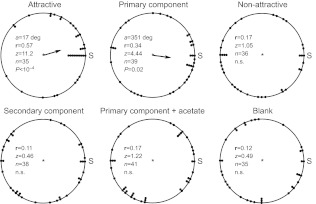Fig. 1.
Helicoverpa zea male orientation at take-off when exposed to different female pheromone compounds. Each point represents a single individual and arrows indicate the preferred direction (Rayleigh test). S indicates the position of the odor source. Treatments are as follows: attractive, Z11-16:Ald + Z9-16:Ald; primary component, Z11-16:Ald; non-attractive, Z11-16:Ald + Z9-16:Ald + Z11-16:OAc; secondary component, Z9-16:Ald; primary component + acetate, Z11-16:Ald + Z11-16:OAc; and blank, hexane. The averaged preferred take-off angles (a), Rayleigh vector lengths (r), z-statistics (z), sample sizes (n) and P-values are shown for each treatment.

